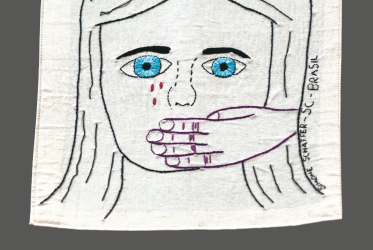Scripture
Matthew 16:21–23—Jesus Foretells His Death and Resurrection
21 From that time on, Jesus began to show his disciples that he must go to Jerusalem and undergo great suffering at the hands of the elders and chief priests and scribes, and be killed, and on the third day be raised. 22 And Peter took him aside and began to rebuke him, saying, “God forbid it, Lord! This must never happen to you.” 23 But he turned and said to Peter, “Get behind me, Satan! You are a stumbling block to me; for you are setting your mind not on divine things but on human things.”—Matt. 16:21–23 (NRSV)
The Text in Its Context
Three of the gospels—Matthew, Mark, and Luke, traditionally named the synoptic gospels—tell the story of Jesus with a dramaturgy or dramatic composition that builds on how Jesus walks to Jerusalem and climaxes in his death and resurrection there. Jesus foretells his suffering three times according to Matthew, Mark, and Luke:
1. First foretelling: Matthew 16:21–23, Mark 8:31–33, Luke 9:22
2. Second foretelling: Matthew 17:22–23, Mark 9:30–32, Luke 9:43b–45
3. Third foretelling: Matthew 20:17–19, Mark 10:32–34, Luke 18:31–34
In all four gospels the enemies are identified as “the elders and chief priests and scribes.” For the most part, the gospels were written during a time when there was a growing conflict between Jews and Gentiles within the Jesus movement. It is important to understand that Jesus himself was a Jew; the Jewish community is Jesus’s context. The person who ultimately sentences Jesus to death is a Roman governor.
Jesus is a threat to the powerful, and he is aware of it. The narrator in the synoptic gospels says that when Jesus tells the disciples about his pending suffering and death they either “were greatly distressed” (Matt. 17:23), “they did not understand what he was saying and were afraid to ask him” (Mark 9:32) or “they understood nothing about all these things; in fact, what he said was hidden from them, and they did not grasp what was said” (Luke 18:34).
Just before Jesus talks about his coming suffering, Peter makes a confession when he states that Jesus is the Messiah. All the synoptic gospels report about the confession. One can imagine the state of mind that Peter is in—being together with the Messiah! And then, suddenly, the scene is dramatically changed: Jesus predicts his death. It is not strange that this causes distress and raises a number of questions amongst the disciples.
The only one who tries to intervene is Peter, and he gets a harsh reprimand from Jesus. One can sympathize with Peter. It seems as if he wants to protect Jesus. The question is, Why does Jesus reject his help? And why is Jesus so dismissive? One suggestion is that Jesus himself feels an uncertainty and reacts when Peter does not listen to him but rather wants to stop him from following his calling. Jesus is a human being and needs support from those closest to him. He does not need for Peter to question his decision to approach the city; he needs Peter’s support. But he gets something else.
It is also clear that Jesus is convinced he has a calling, a path he must follow. This clarity is evident —not only in this passage but also in the garden of Gethsemane where Jesus is determined to follow the road set before him although he is filled with anxiety.
The Text in Our Context
We, like Peter and the other disciples, experience sudden shifts in life. Life can be good and safe, and we are filled with gratitude. Then, without warning, things change, and we find ourselves in the deep end. Every person goes through this. It is part of human life, and it happens from an early age.
In the context of gender-based violence, women and children often find themselves in situations when trust and security change into mistrust and fear. One example is when they travel home from school or work. Depending on their context, they must consider which route is safe to take. Just like Jesus is aware of the threats that are present when he approaches Jerusalem, many women and children know when they are in unsafe environments. It can happen in daylight and even more in the dark of night.
Jesus had a task to fulfil. He was not prepared to change plans because there was a threat. In fact, many women and children are forced to change plans because of threats that surround them. There are many girls who cannot attend school because of this. Some young people decide to stay at home during late afternoon or evening in parts of the world where activities are offered at these times because it is not safe to go out. Yet we also have to remember that violence and sexual abuse also is a reality in many homes. This is the case more often for girls than for boys.
Sometimes this is their own choice, but in other instances, parents and others advise girls and young women how they should act to avoid the risk of being harassed. This advice may have to do with how they dress but also with which path they literally walk. Such advice is very problematic since often puts blame on the victim. It often seems as if parents do this to protect their daughters. At the same time, it means that they restrict their daughters’ freedom. If one is honest as a parent, one must admit that there are different rules for sons and daughters. Again, parents make a decision in order to protect their children, but the result is that the children are harmed.
The problem does not lie with women and children. The problem is structural. Men are often—not always but in most cases—the perpetrators of harassment and violence against girls and women. So, it has to do with gender roles. And society does not often prioritize the creation of safe neighbourhoods for all. Sometimes people with authority, like politicians, recommend that people in unsafe areas stay at home. Presumably, this is done out of consideration for these residents, but the result is that some people cannot move as freely as others.
Questions
About the Text
• Share thoughts about Peter’s reaction when Jesus tells the disciples about his coming suffering. Can you identify with Peter? In what way?
• Share thoughts about Jesus’s reply. Can you relate to his reaction?
About Our Context
• Think about situations when you have tried to warn someone to keep them from being exposed to danger. In the context of gender-based violence, what is the best strategy? If you are a parent or guardian, how are you acting in relation to your children, or how did you act when they were younger?
• Have you yourself experienced times when others have restricted your possibilities to move freely? How did parents, society do this?
Activities
• Identify unsafe areas and situations in your context and discuss strategies to make these places and situations safer, especially for women and children. You might bring this to the attention of a group within your congregation/parish.
Prayer
Loving God, we come to you in situations when the freedom of some people is being restricted or limited by other people’s actions or by structural injustices. Guide us when we seek to navigate in an uncertain terrain. Protect the vulnerable and challenge people with power. In Jesus’s name, amen.





